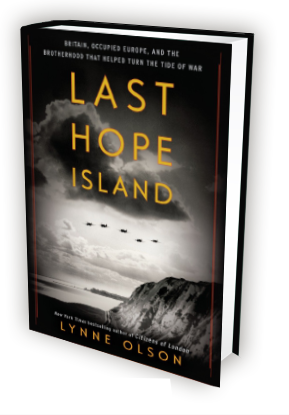New York Times bestselling author Erik Larson (Dead Wake) called it “A rip-roaring saga of hair-breadth escape, espionage, and resistance.” Being Nixon‘s Evan Thomas notes “Lynne Olson is a master storyteller.” I could not agree more with either of these gentlemen, and I am delighted to share with you, dear readers, this week’s #SaturdayScene from bestselling author Lynne Olson.
espionage, and resistance.” Being Nixon‘s Evan Thomas notes “Lynne Olson is a master storyteller.” I could not agree more with either of these gentlemen, and I am delighted to share with you, dear readers, this week’s #SaturdayScene from bestselling author Lynne Olson.
Excerpted from her latest work, Last Hope Island—an epic, character-driven narrative of Britain, Occupied Europe, and the Brotherhood That Helped Turn the Tide of War—this week’s #SaturdayScene opens on the eve of Germany’s invasion of Denmark and Norway, April 1940.
“On April 8, 1940, just after midnight, officials in the Norwegian government were awakened by urgent phone calls informing them that several ships of unknown origin had entered the fjord leading to Oslo. A sea fog blanketing the fjord made it impossible to identify the ghostly armada’s markings. Within minutes, however, the mystery of their nationality was solved when reports of surprise German attacks on every major port in Norway and Denmark began flooding Norwegian government offices.
Aboard the German heavy cruiser Blücher, Gen. Erwin Engelbrecht, who commanded the attack force heading for Oslo, reviewed his orders with his subordinates. In just a few hours, more than a thousand troops, equipped with minutely detailed maps and photographs of the Norwegian capital, were to disembark from the Blücher in Oslo’s harbor. Their assignment was to slip into the sleeping city and storm government buildings, the state radio station, and the royal palace. Before noon, King Haakon, Crown Prince Olav, and the rest of the royal family would be under arrest and the Norwegian government under German control. A band, also on board the Blücher, would play “Deutschland Uber Alles” in the city’s center to celebrate Germany’s triumph, while German military officials took over administration of the country and its two most important material assets — its merchant marine and its gold.
When a Norwegian patrol boat spotted the flotilla and had the temerity to issue a challenge, the boat was machine-gunned and sunk. Further up the fjord, two small island forts, alerted by the patrol boat, also fired on the ships, but the heavy fog made accurate sighting impossible and the vessels swept on untouched. Shortly before 4 a.m., the convoy approached Oscarborg Fortress, an island stronghold built in the mid-nineteenth century and Oslo’s last major line of defense. The Blücher’s captain was as unperturbed by the sight of the fortress as he had been by the pesky patrol boat. On his charts and maps, Oscarborg was identified as a museum and its two antiquated cannons described as obsolete.
The maps and charts were wrong on both counts. The fortress was operational, and so were the old cannons, fondly called “Moses” and “Aaron” by their crews. The fog lifted a bit, and as the darkened silhouettes of the ships came into view, a searchlight on the mainland suddenly illuminated the Blücher. Moses and Aaron erupted at point-blank range, their shells crashing into the 12,000-ton heavy cruiser. One shell smashed into the Blucher’s bridge, destroying its gunnery and navigational controls, while another slammed into a storeroom filled with aviation fuel. Shore batteries also began firing. Within seconds, the Blücher was ablaze, the flames leaping high in the air, burning off the fog and lighting up the snow-covered banks of the fjord.
With a great roar, the ship’s torpedo magazine exploded, and less than an hour later, the Blücher, commissioned only seven months before, rolled over on its side and sank. Nearly one thousand men went down with her, including most of the elite troops assigned to capture the royal family and government officials. Gen. Engelbrecht was one of the several hundred survivors who escaped the burning oil covering the fjord’s surface and swam frantically to shore.
Throughout that day –April 9, 1940 — Hitler’s audacious, meticulously planned invasion of Denmark and Norway had gone almost exactly as planned. By early afternoon, virtually all the Fuhrer’s major objectives along 1,500 miles of Norwegian coastline had been taken. All, that is, except Oslo, the political, economic, and communications center of Norway and the key to the operation’s eventual success.”
Order your copy from Amazon | Apple | B&N | Kobo or from your favorite Indie bookseller.
About the Author: Lynne Olson is a New York Times bestselling author of seven books of history, most of which deal in some way with World War II and Britain’s crucial role in that conflict. Born in Hawaii, Olson graduated magna cum laude from the University of Arizona. Before becoming a full-time author, she worked as a journalist for ten years, first with the Associated Press as a national feature writer in New York, a foreign correspondent in AP’s Moscow bureau, and a political reporter in Washington. She left the AP to join the Washington bureau of the Baltimore Sun, where she covered national politics and eventually the White House. Olson lives in Washington, DC with her husband, Stanley Cloud, with whom she co-authored two books.
Visit Lynne Olson’s website to learn more.

Leave a Reply